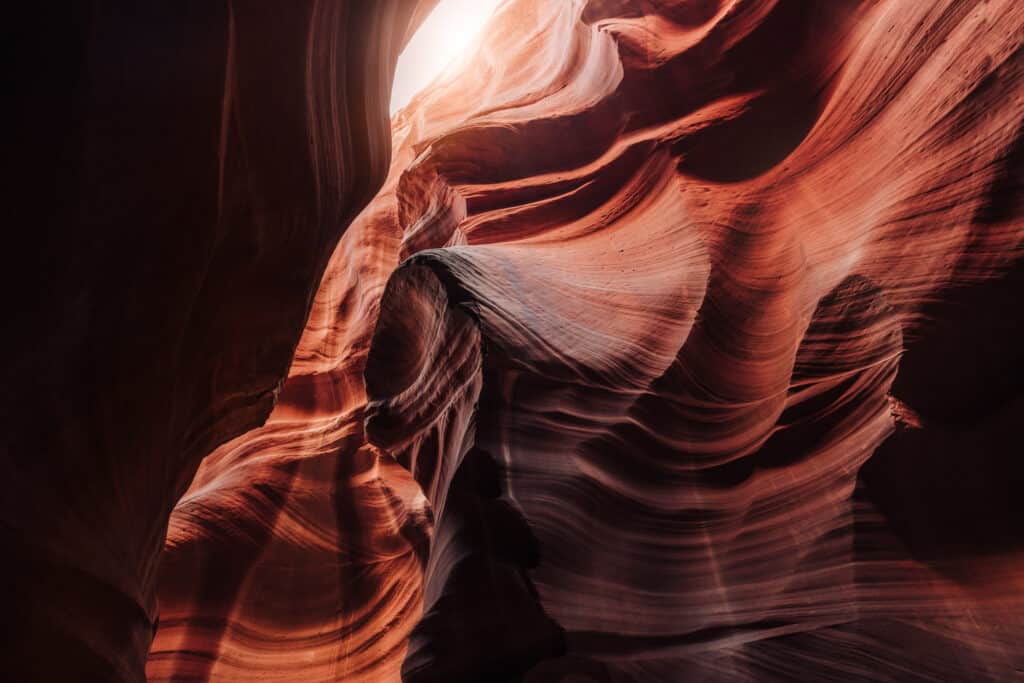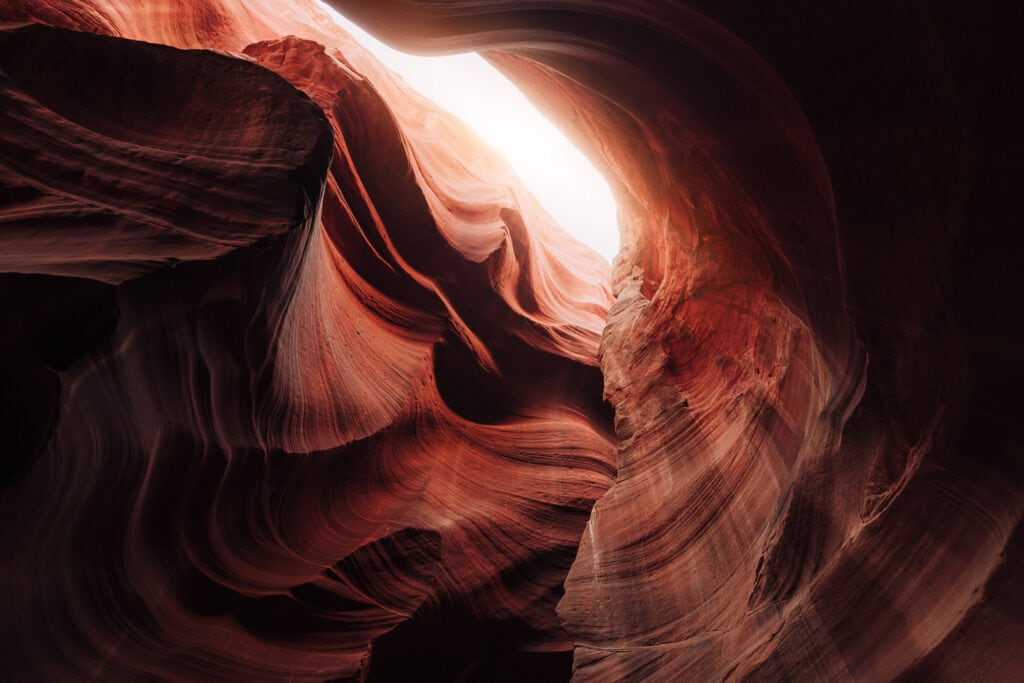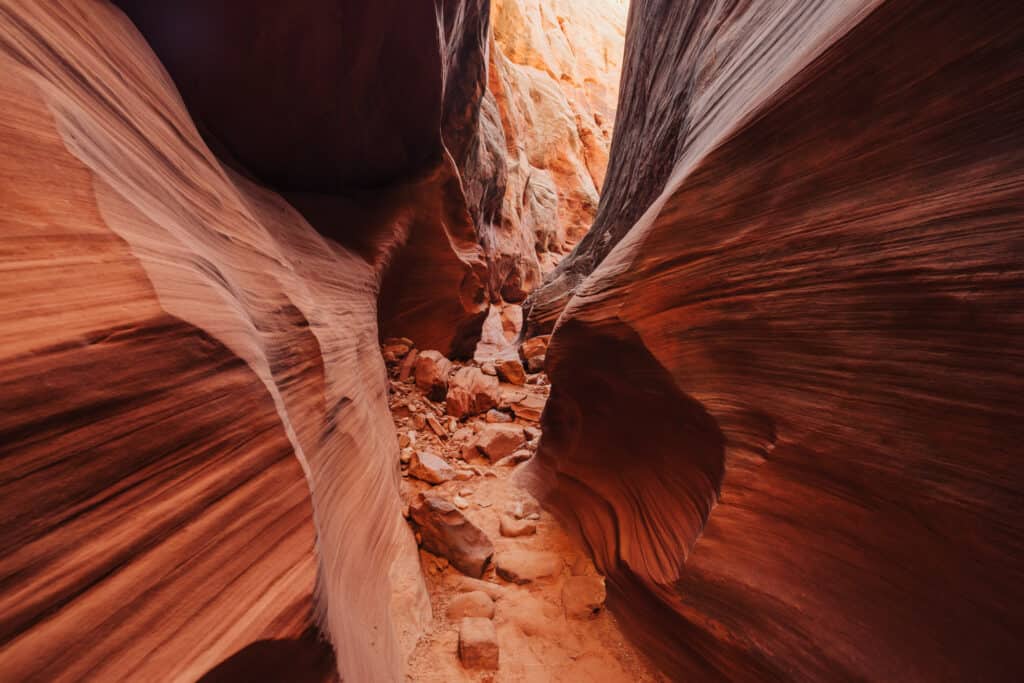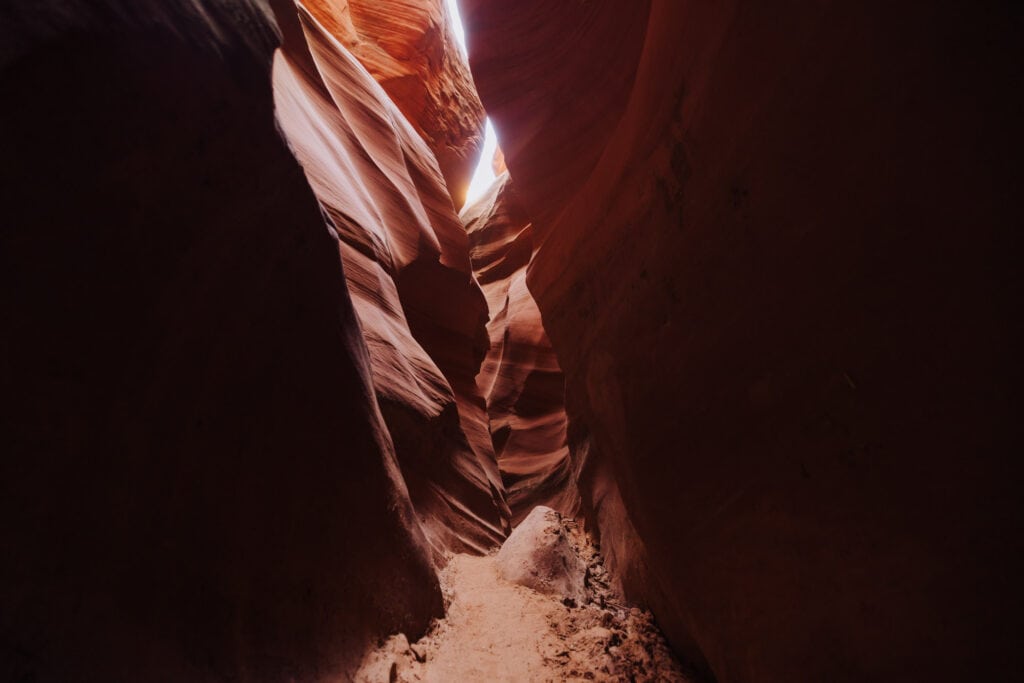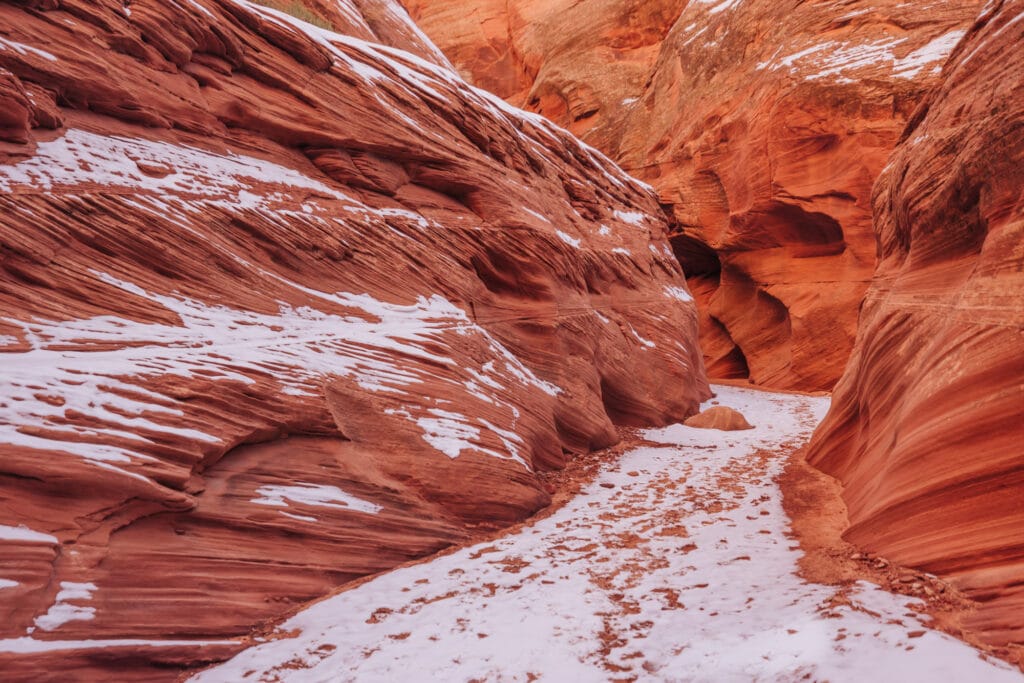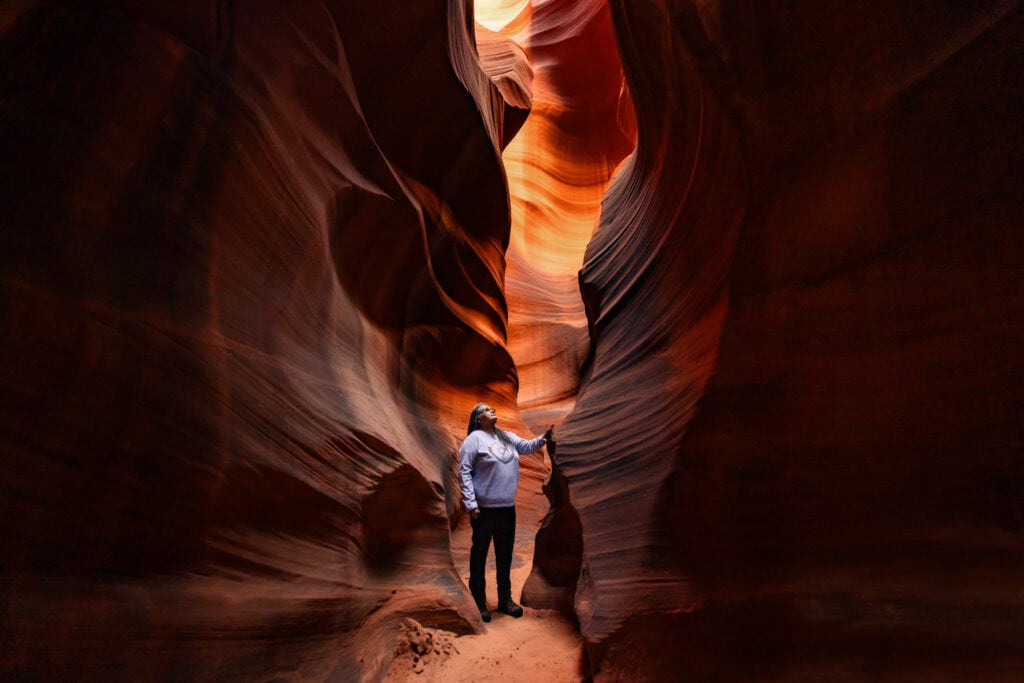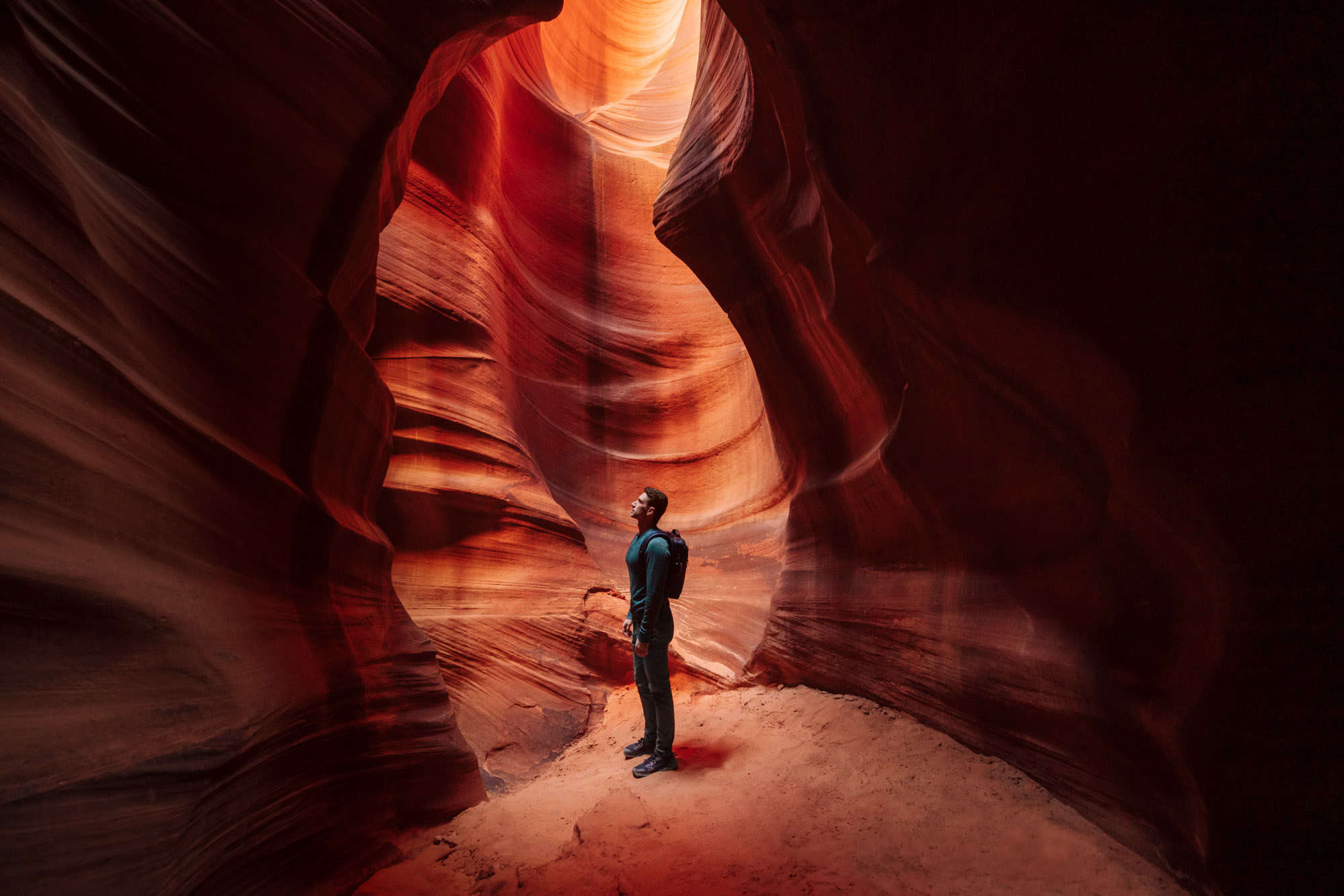Cardiac Canyon: Antelope Canyon’s Least Crowded and Best Photography Tour
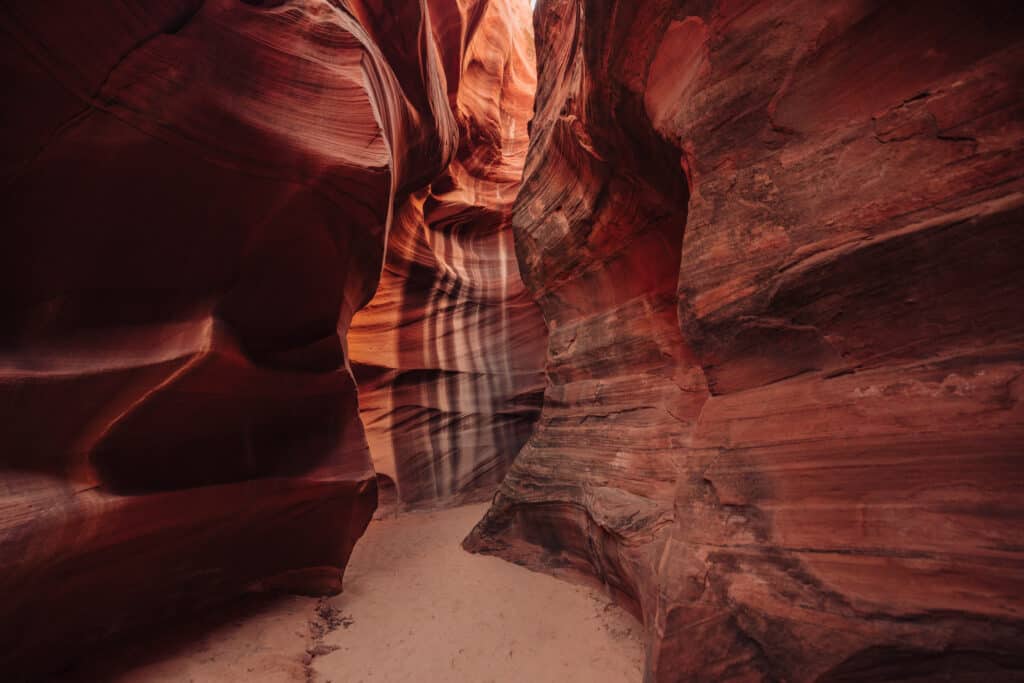
Cardiac Canyon is part of the desert drainage system which eventually empties into Lake Powell, in Page, AZ. It’s (by far) the least crowded part of Antelope Canyon, and the hike is probably the most strenuous of any of the options.
Cardiac Canyon only opened to the public a few years ago, and tours are capped at just six people per day.
For perspective, more people walk through Lower Antelope Canyon each day, than walk through Cardiac Canyon all. year.
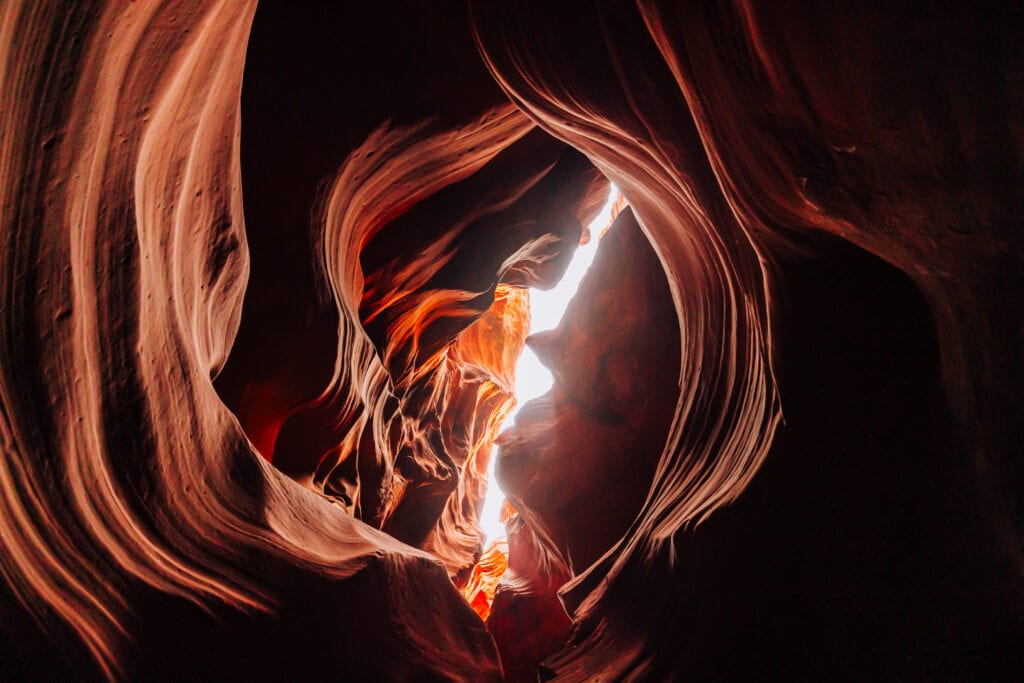
Key Info on Cardiac Canyon Tours:
- The family operating tours has lived on the land since the 1860s.
- Tours usually run from 8:00am to 2:00pm.
- Two guides accompany the daily group of six visitors.
- The hike is 2.5 to 3 miles, done over the course of six hours.
- You’ll get plenty of solitary time inside the canyon’s chambers and narrow passageways.
- You can bring photography equipment.
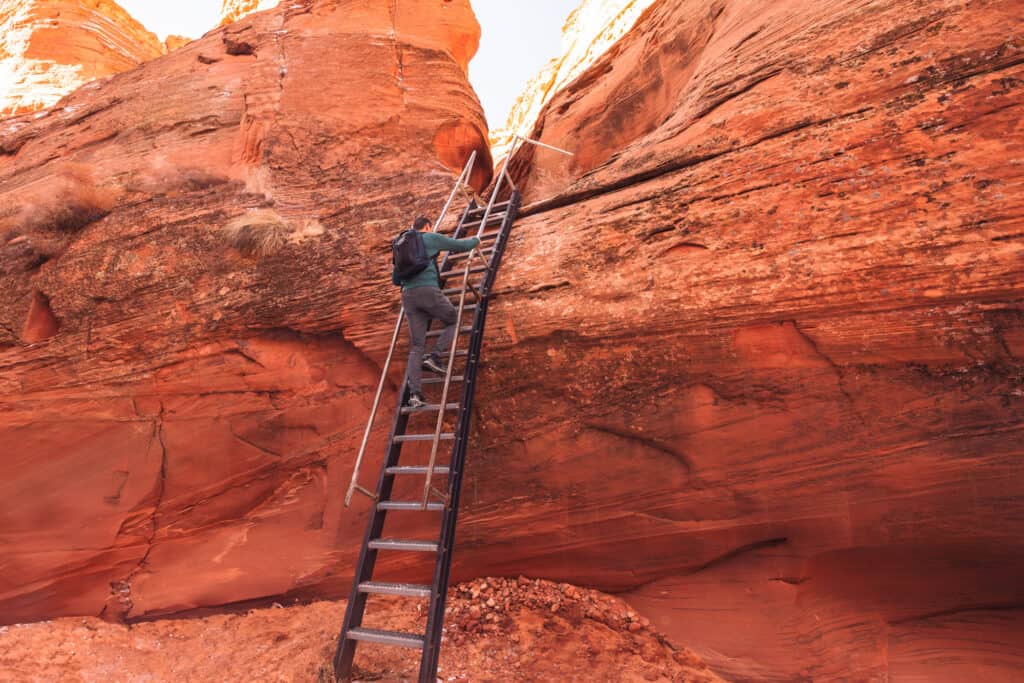
Where is Cardiac Canyon
Parking for Cardiac Canyon is about 12 miles outside Page, AZ, right along Highway 98.
From there, it’s a 7-mile ride to the entrance.
More broadly speaking, Cardiac Canyon is part of a larger desert wash system more commonly referred to as Antelope Canyon. It gathers rainfall and sends it flowing into what is now Lake Powell.
Hotels Near Cardiac Canyon
Cardiac Canyon is just outside Page, AZ, which is home to a growing number of hotels. You can plug your dates into this interactive map (which is much easier to use on a desktop) to see what hotel and rental options are available for your trip.
What to Expect on a Cardiac Canyon Tour
Several things set a Cardiac Canyon tour apart from any of the other dozen-or-so tours of Antelope Canyon:
- You’ll have 2 guides.
- It’s 6 hours long, with no rush and plenty of peaceful solitude.
- You can bring photography equipment.
One of the tour guides will be well-versed in culture and history. The other will be able to help you physically get through the canyon, and get your bags and other things in and out.
I went on a rare snowy day. Most of the time, you’ll be walking through sand, not snow 😀.
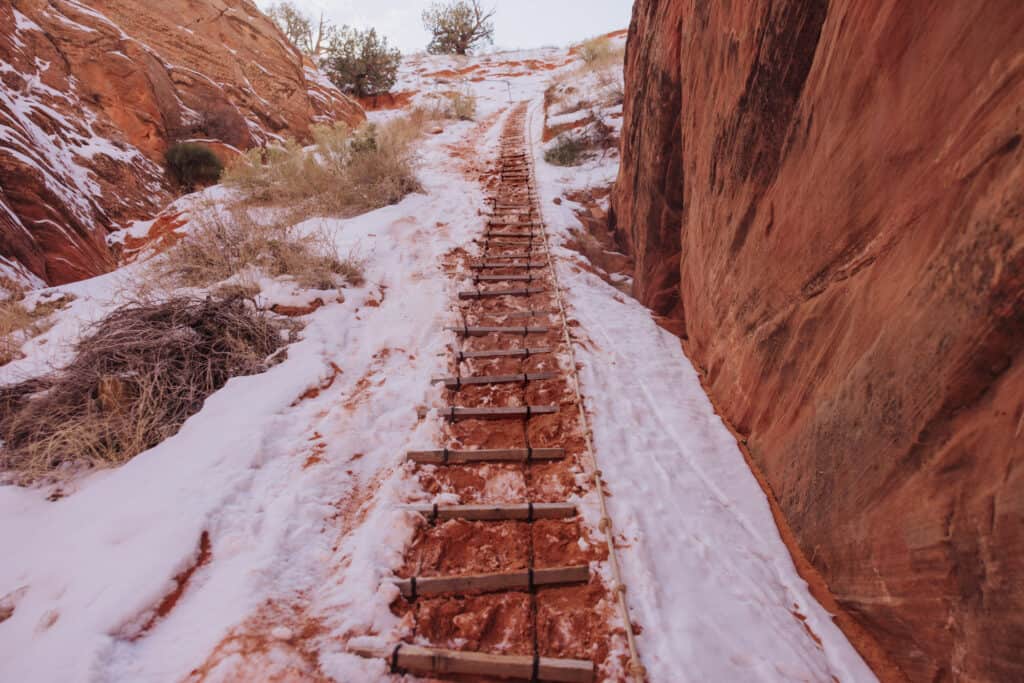
The Cardiac Canyon Hike
The Cardiac Canyon tour begins with a van ride, about 7 miles through the desert on Navajo land to the canyon’s entrance.
You’ll slide down a trail through the sand dunes into the canyon to begin your hike. There’s a rope ladder to help you out. You’ll also use it to climb back out of Cardiac Canyon later!
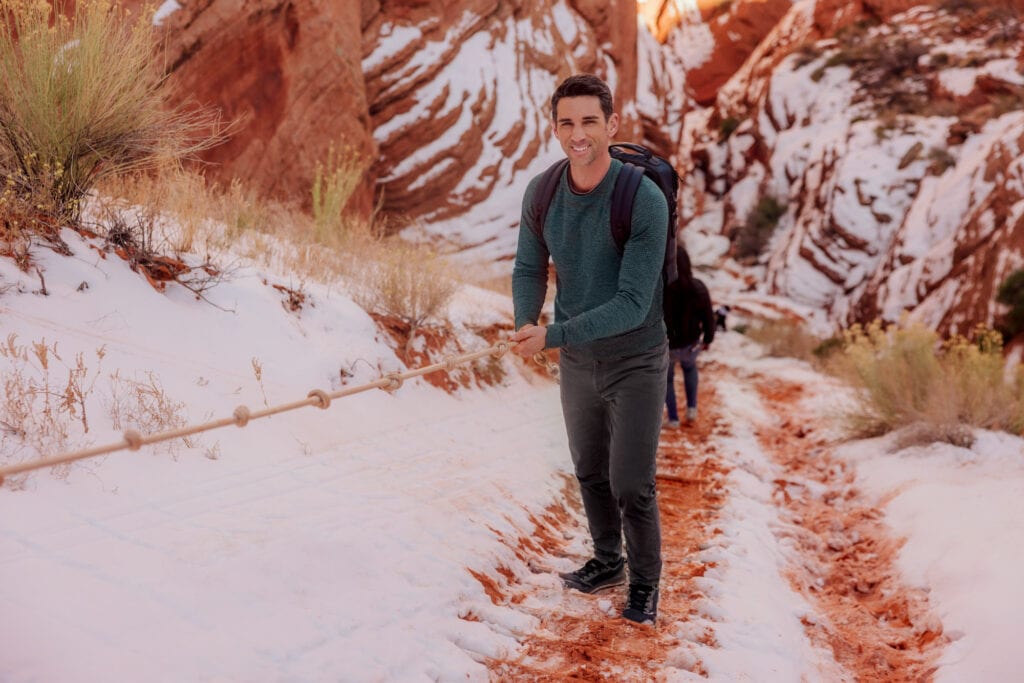
You’ll find patterns carved on the sandstone walls, in addition to the waves carved by nature over the years.
Photographers love capturing Cardiac Canyon’s beams of light, which usually appear midday from April through September.
The guides will lead you around the different parts of the canyon, which stretches around 2.5 miles.
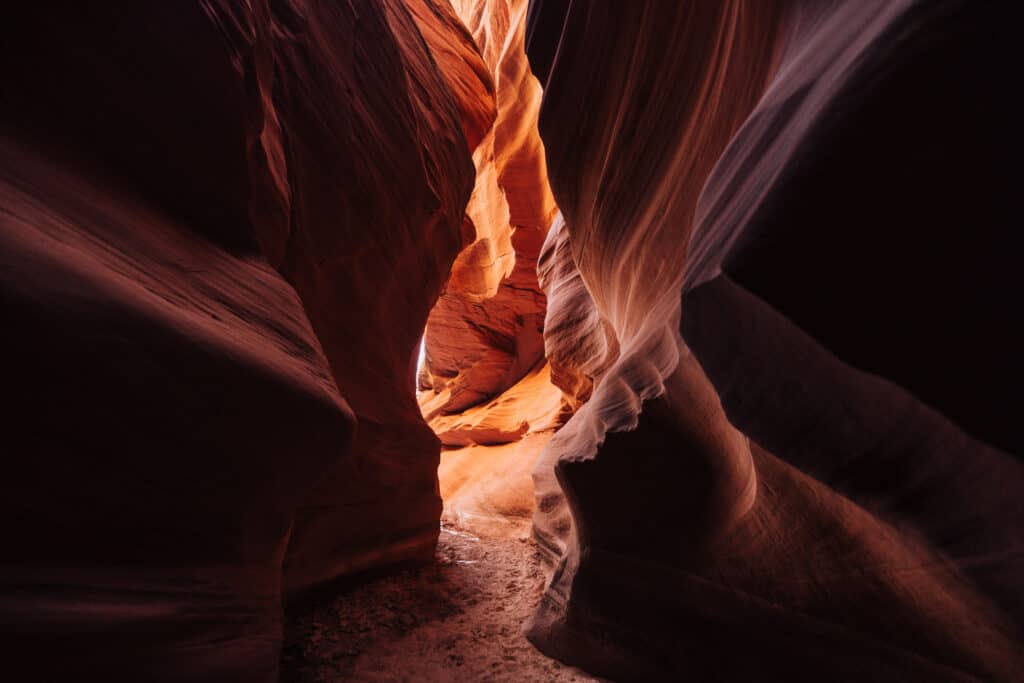
They’ll also leave you on your own for hours at a time, giving photographers plenty of time to setup their shots. They’ve had people bring books to read, and yoga mats to stretch out on.
It’s peaceful and quiet the entire time.
You’ll encounter ladders and metal steps embedded into the rocks in certain areas, which will help you ascend and descend to different parts of the canyon.
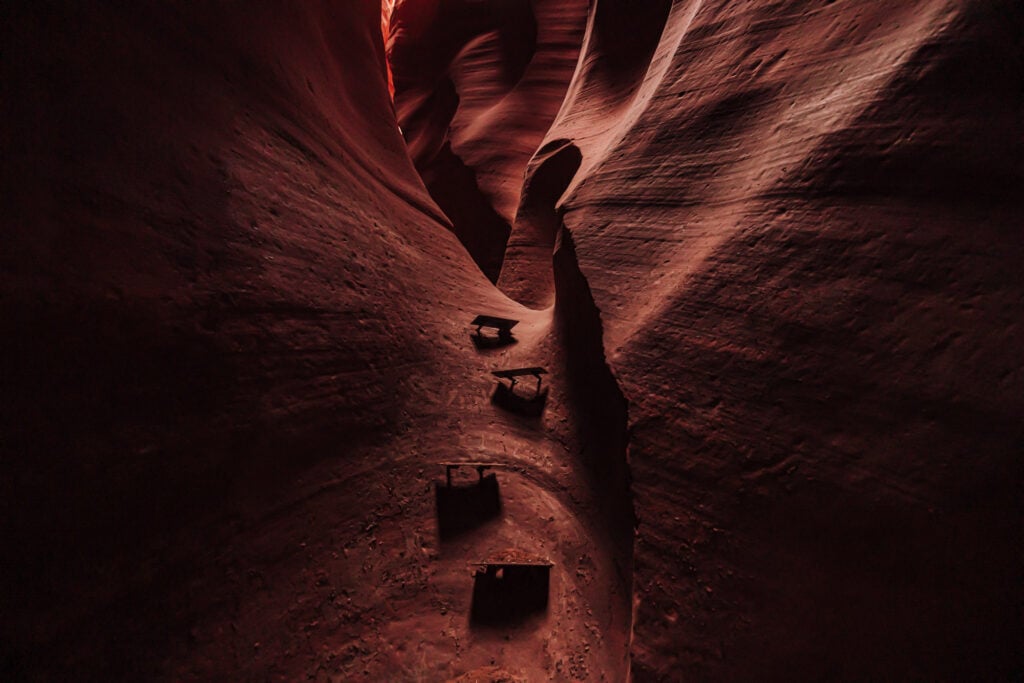
The Chambers
Some say Cardiac Canyon gets its name from the chambers in one of the sections. The chambers can be compared to the chambers in a heart?
This is where you’ll find carvings on the walls, along with natural patterns from the minerals, and what some say are patterns left by smoke from fires many years ago.
The light filters in from above, beautifully illuminating the Navajo Sandstone walls.
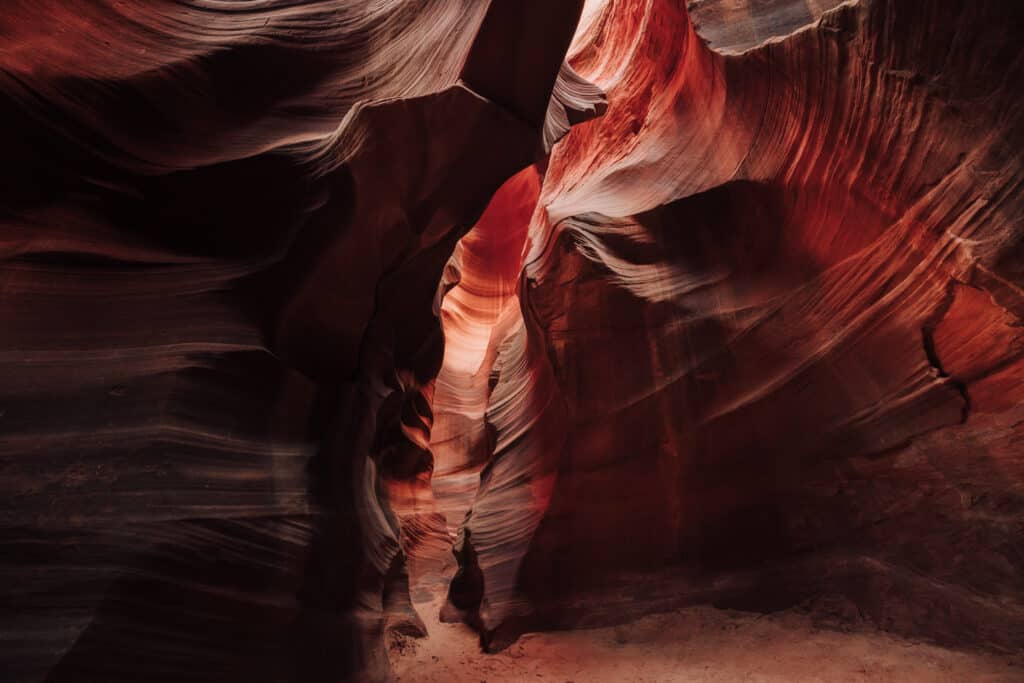
Interestingly, the depth of the sand here and in all parts of Antelope Canyon changes over time, as floods wash through.
You’ll also notice debris lodged in the rocks, brought in from the last flood.
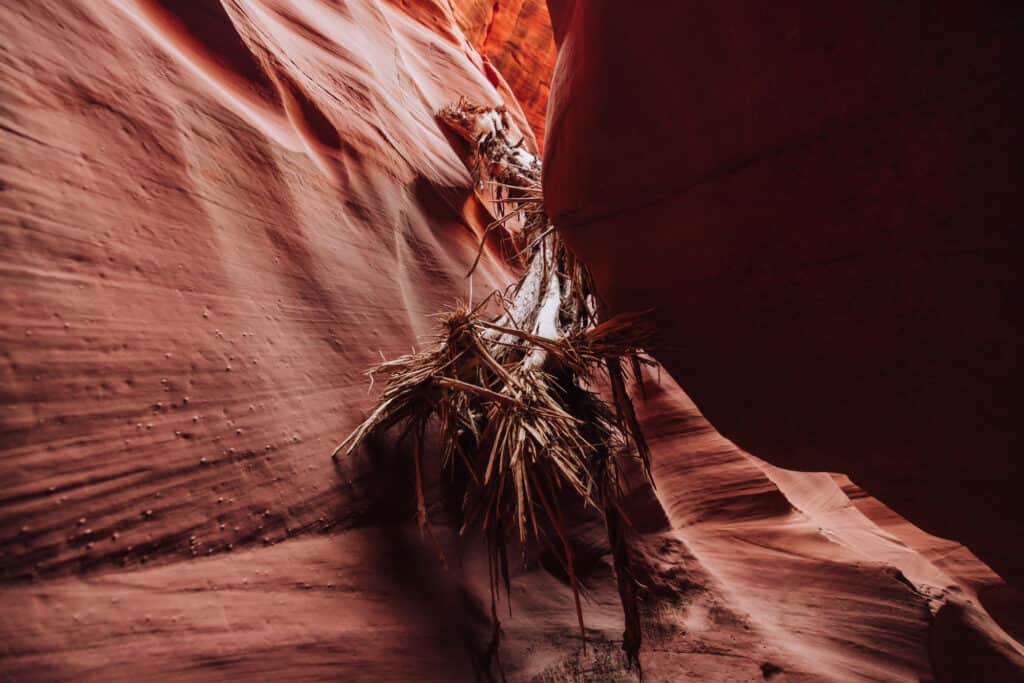
In a couple spots, storms washed boulders down onto the path, which you’ll have to climb under or over.
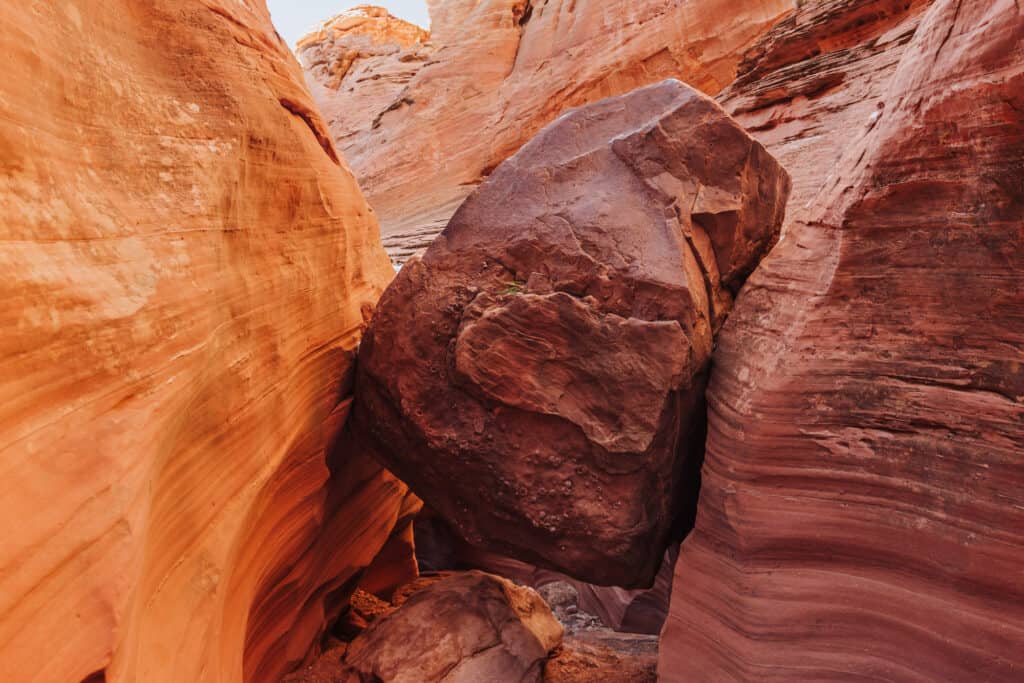
The Narrows
If you’ve been to other parts of Antelope Canyon, you may have had to slip through some pretty tight spots in the slot canyon.
Parts of Cardiac Canyon are the narrowest I’ve ever been through!
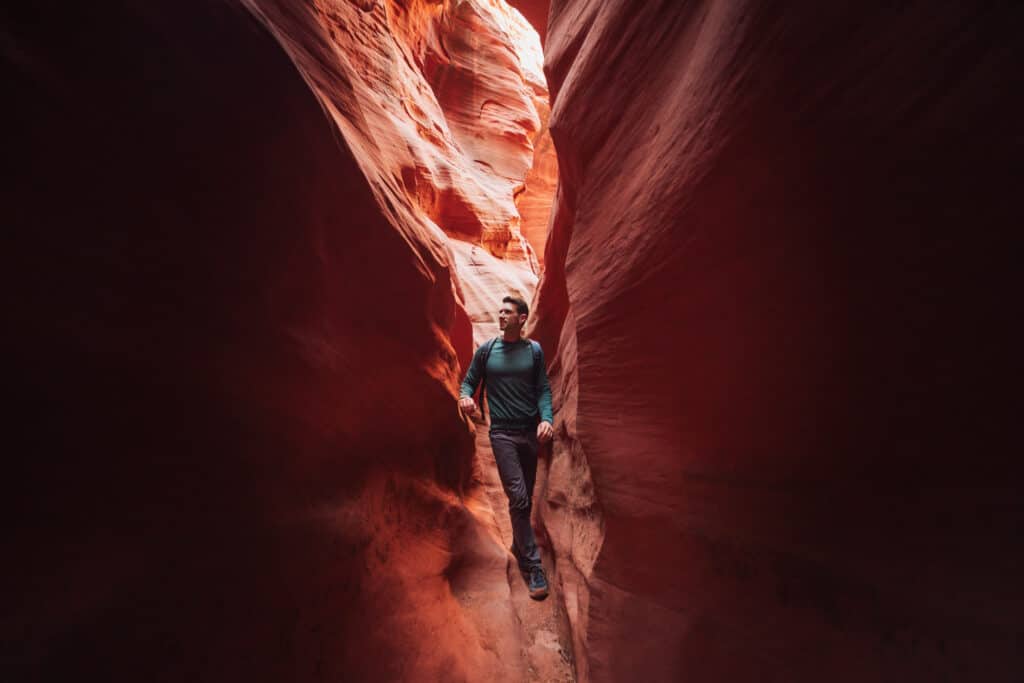
Part of your tour will include time in this section of the canyon, where you’ll have to squeeze through crevasses to continue to the steep canyon wall at the end.
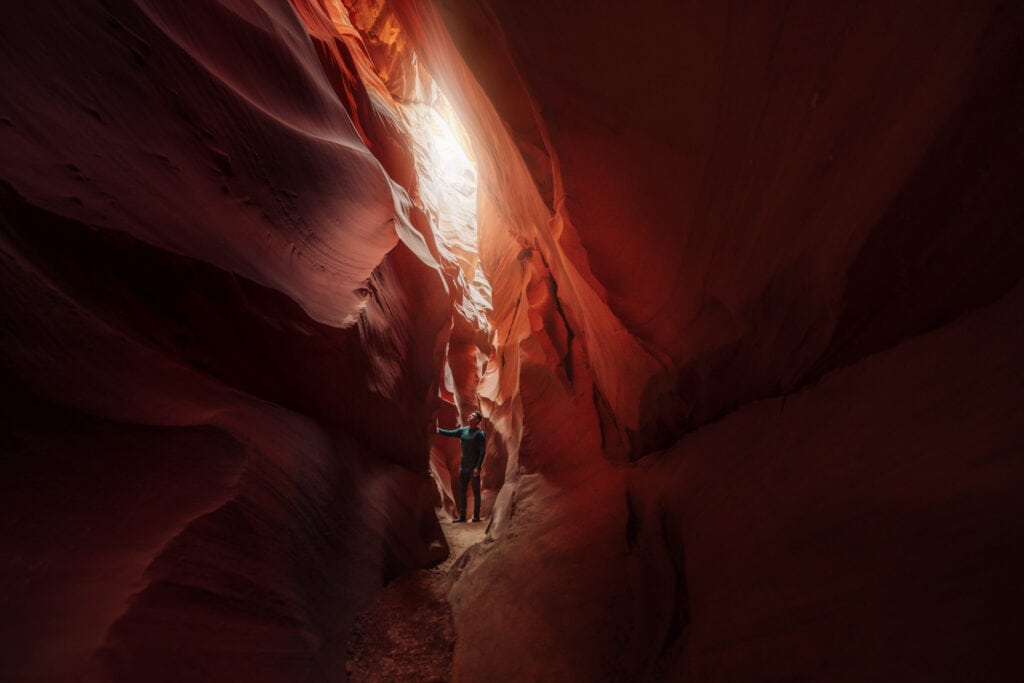
Petroglyphs and Markings
There are ancient carvings in a few spots in Cardiac Canyon. One of the carvings is now the symbol of Cardiac Canyon.
The oval-shaped swirl pattern is thought to represent crops in the field.
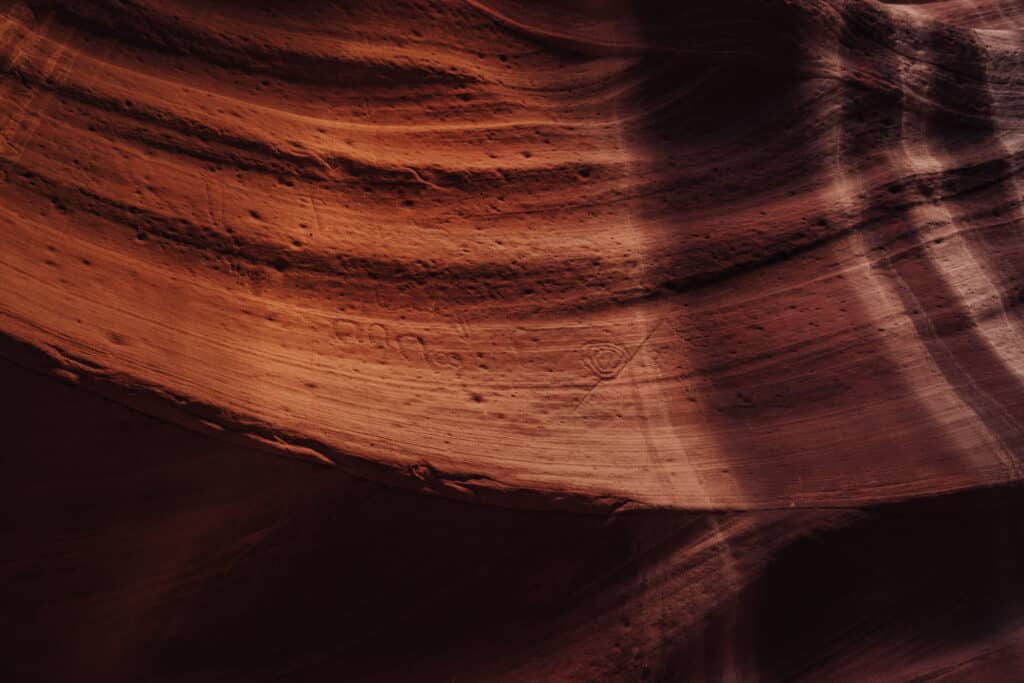
Nearby, vertical dark streaks line the canyon walls. Is it the result of smoke rising from a fire in the chamber, as some in the family suspect, or natural markings in the rock, or both?
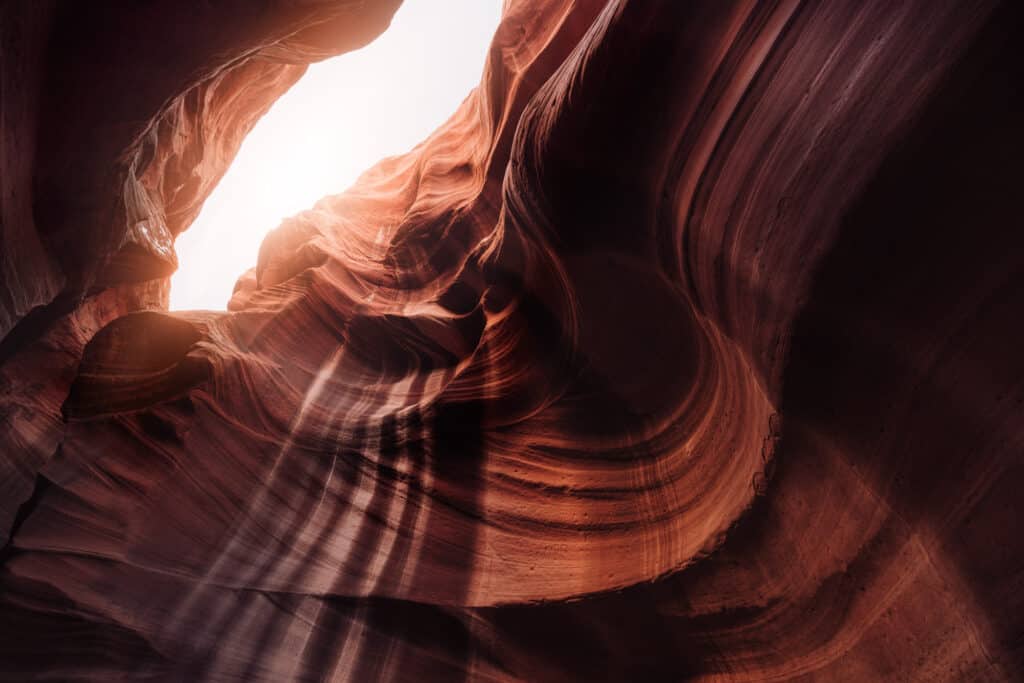
In nearby Antelope Canyon X (operated by the same family) there’s another interesting marking on one of the walls.
A man named Lloyd C. Ashley carved his name into the sandstone in October of 1918. He was working for the Navajo Copper Mine at the time, searching for a spot to build a dam to generate power for the mine.
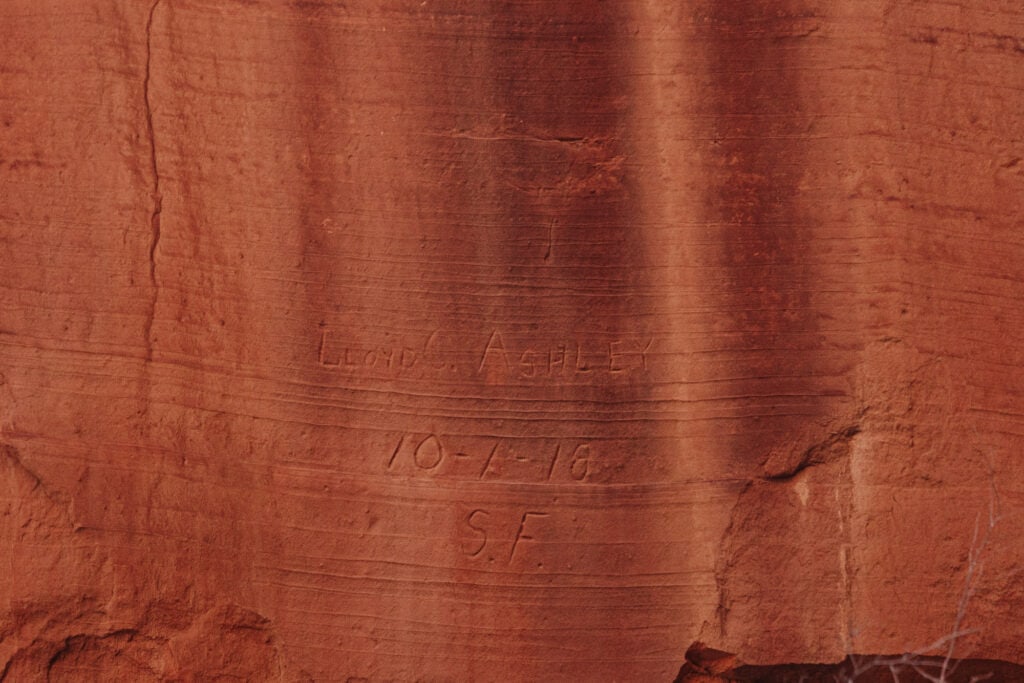
Book a Cardiac Canyon Tour
Cardiac Canyon tours are offered exclusively by Taadidiin Tours, which is based right along Highway 98, 12 miles outside Page.
They release tour dates each quarter, throughout the year:
- January – March tours are available to book December 1st.
- April – June tours are available to book January 1st.
- July – September tours are available to book April 1st.
- October – December tours are available to book July 1st.
Cardiac Canyon Tour Cost
The cost of the 6-hour tour is $228, plus an $8 permit fee. It amounts to about $40 per hour. Plus, remember to bring some cash to tip your guides!
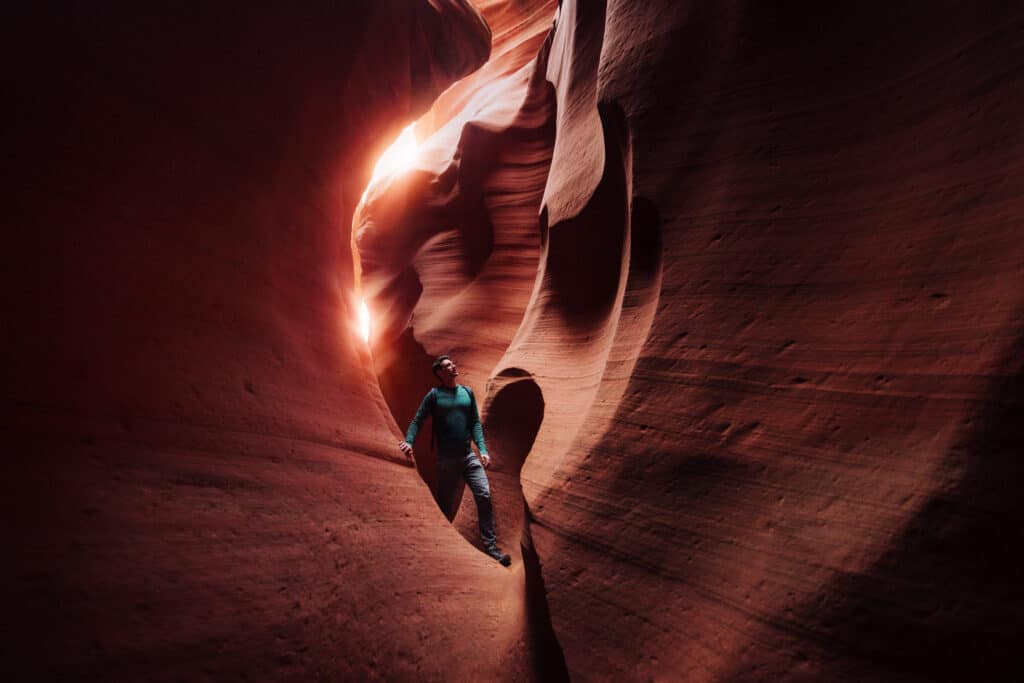
Do a Cardiac Canyon / Antelope Canyon X Combo Tour
Taadidiin Tours also offers a combo, full-day tour of both Cardiac Canyon and the nearby Antelope Canyon X.
The combo tour is $268 per person.
After your 6 hours in Cardiac Canyon, you’ll go on a one-hour tour of Antelope Canyon X in a small group. Antelope X consists of two parts of the slot canyon, which you’ll visit with a guide.
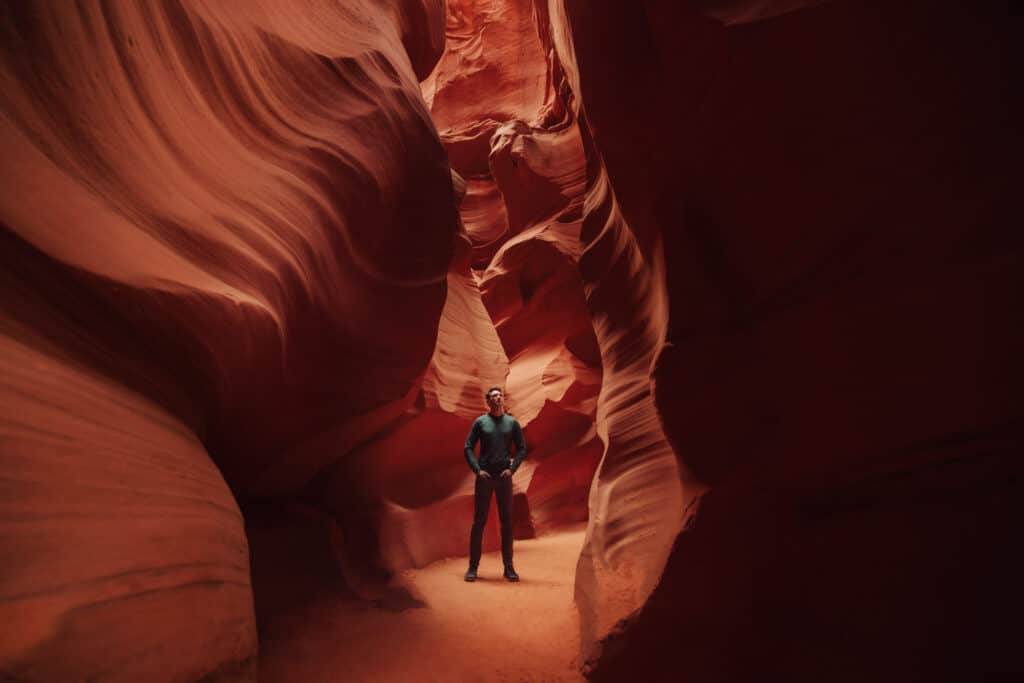
The Best Time to Visit Cardiac Canyon
Any time of year is good, but of course summers can be hot and winters can be snowy and cooler.
If you’re a photographer looking for the beams of light in the canyon, they usually appear from April through the summer, midday.
One thing to be aware of is the summer monsoon season, which can send storms through the area. It usually begins in late June and lasts through September. Most days, it’s not a problem at all, but several times each year different sections of the canyon close due to the threat of flash flooding.
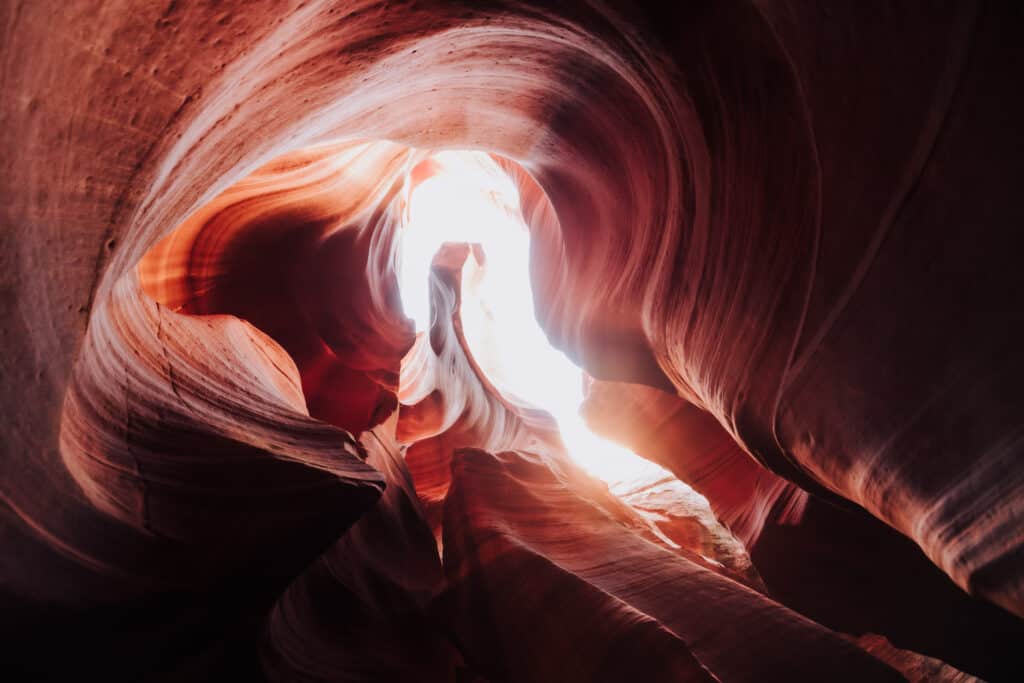
The Tragic History of Cardiac Canyon
The family operating tours of Cardiac Canyon has roots on the land dating back to the 1860s. Around the time of the Civil War, the government forcibly removed 10,000 people from their native land. A few remained, hiding in the slot canyons with the help of Hastin Tadidinii, whose descendants still live here today.
For generations, the terror the Navajo families endured during the “long walk” to an internment camp at Fort Sumner in New Mexico, wasn’t spoken of. Hundreds of people died and starved along the way. The losses of people, families, animals, crops, and land were all too heart-breaking.
After four years at Fort Sumner, a treaty was signed to allow Navajo families to return to their homeland, which was designated as the sovereign Navajo Nation. As part of the agreement, however, the Indian Boarding School System was created. Children were taken from their families and sent to forced assimilation programs in the school. Their hair was cut, their traditions were banned, and their native languages were forbidden.
Only recently have younger generations begun talking about their families’ histories, and encouraging their elders to document their experiences.
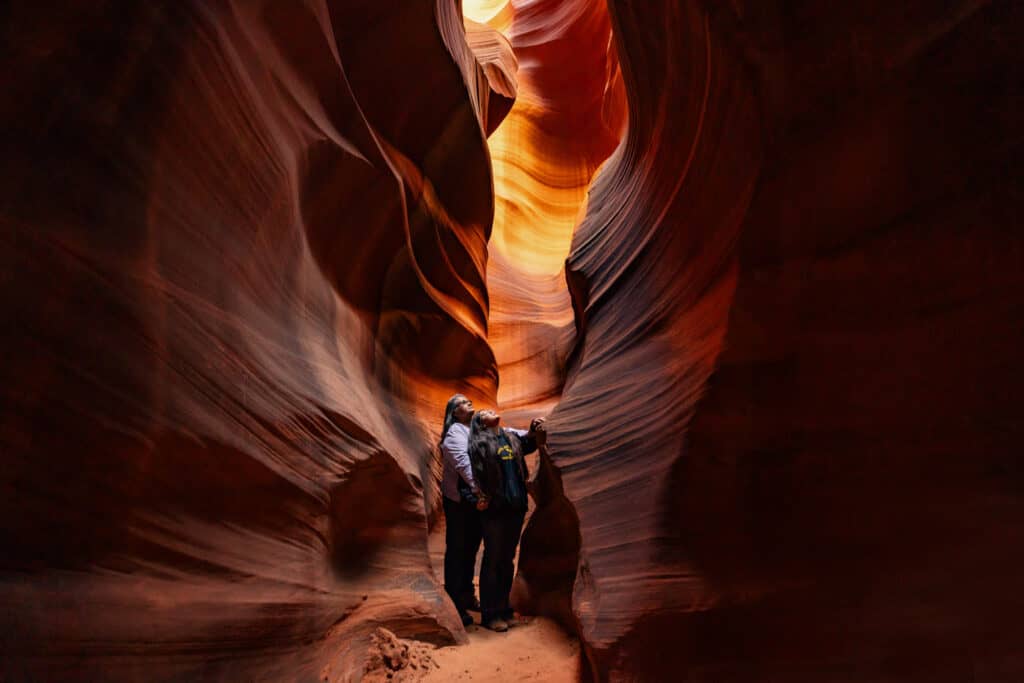
An Interview With the Family Behind Cardiac Canyon
I spent time with Logan Tsinigine and his family recently, and we were joined for a while by the matriarch of the family, Rita.
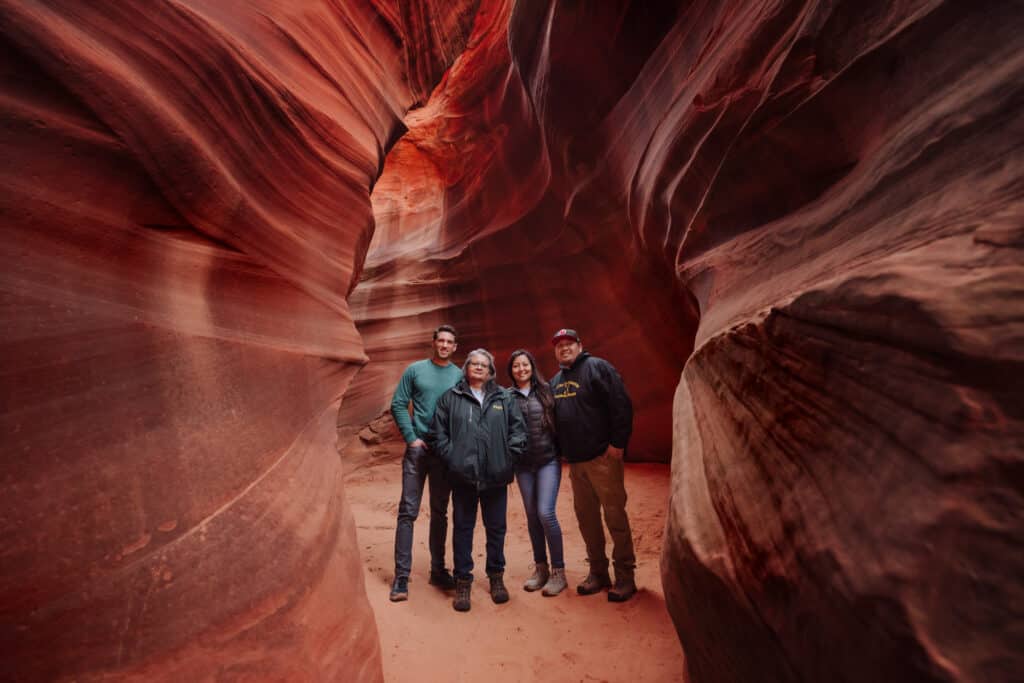
Logan helps run the tour operation. He worked as an engineer at the power plant for several years, before it closed. He got his MBA, and uses the skills to manage and expand the family business.
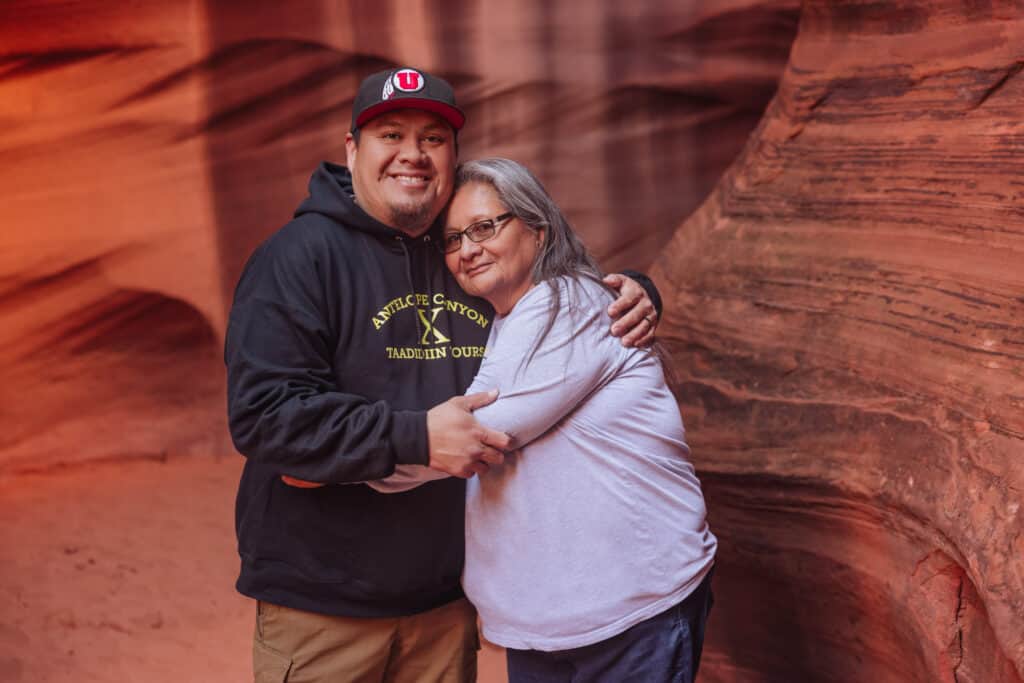
This is a transcript of part of our conversation.
Jared Dillingham: It’s hard to believe this was your family’s backyard.
Logan Tsinigine: It took a long time to realize the beauty of the canyon. When we were young we’d come hike in the canyon and ride horses. We had animals and livestock, like sheep and cows. It was basically like growing up on a Native American ranch. We’d come to the canyons to hike and run, which helped us physically. So growing up here was awesome and now we get to share it with the world, which is great.
Jared: After all these years, how did the family decide to open Cardiac Canyon to the public?
Logan: Our family originally was very reserved in sharing our story and our history with the outside world. We’d always kept these canyons secret and to ourselves. We knew the significance and the importance of what happened here. Time has changed and evolved, and now we’d like to get our story out. We’d like to share it with everyone so they know what really happened, and how we survived. Now we get to share that story. Everyone who comes and meets us, they feel a little closer to the native people and to the land.
Jared: Was part of it a fear that these stories would be lost to history?
Logan: The manifest destiny and boarding school movement almost erased our people. The “long walk” period and assimilation through the boarding schools erased a lot of our history. A lot of our history was oral at the time. So we had to bridge a gap between that era, and use the written word, audio and video. We have to get this known so we aren’t forgotten, and the real history comes out.
We limit the number of people here to have an intimate experience and share that. In Navajo culture, things were passed on orally, face-to-face, in ceremonies and sweat lodges, and personal spaces with family and friends. Now we get to treat other cultures and races the same way. They become our friends for the time they’re here.
Jared: You get visitors from all walks of life. What do you hope they get out of this experience?
Logan: I hope they take a part of history with them. Our story and locations are remnants and are all real. You can come and see the real-life museum of how we lived and how things were, and we can tell you stories that go back. The tragic history we have? We were told we shouldn’t bring it up. We do know now that if things are lost, history tends to repeat itself and that’s what we don’t want.
Jared: You also want people to walk away with a better appreciation for the land?
Logan: Our main goal with Cardiac Canyon and the tours here is that visitors have a deep connection with Mother Earth. In our culture, we have Father Sky, which includes the sun, and Mother Earth. Without the two we don’t exist. This Cardiac Canyon tour specifically gives you 6 to 8 hours in the canyon to be with Mother Earth. There’s no hurry, and no rush. You get to ground yourself and get back to nature. For a lot of our visitors, that’s what they need. They’re coming from the city and from a busy life. They get to come here and decompress. When they leave, they’re happy. We can also share with them the significance of the canyon and our history and our culture.
Jared: Between Cardiac Canyon and Antelope Canyon X, you’ve been open less than 10 years but you employ a lot of people.
Logan: At any given point in the season, we average 50 employees. We’ve developed a lot of our own talent in-house to take over HR, legal, and other professional careers in the company. We also have tour guides, supervisors, drivers, and other office staff. For us, that gives back to the local economy and helps the unemployment rate, which is still very high on the reservation today.
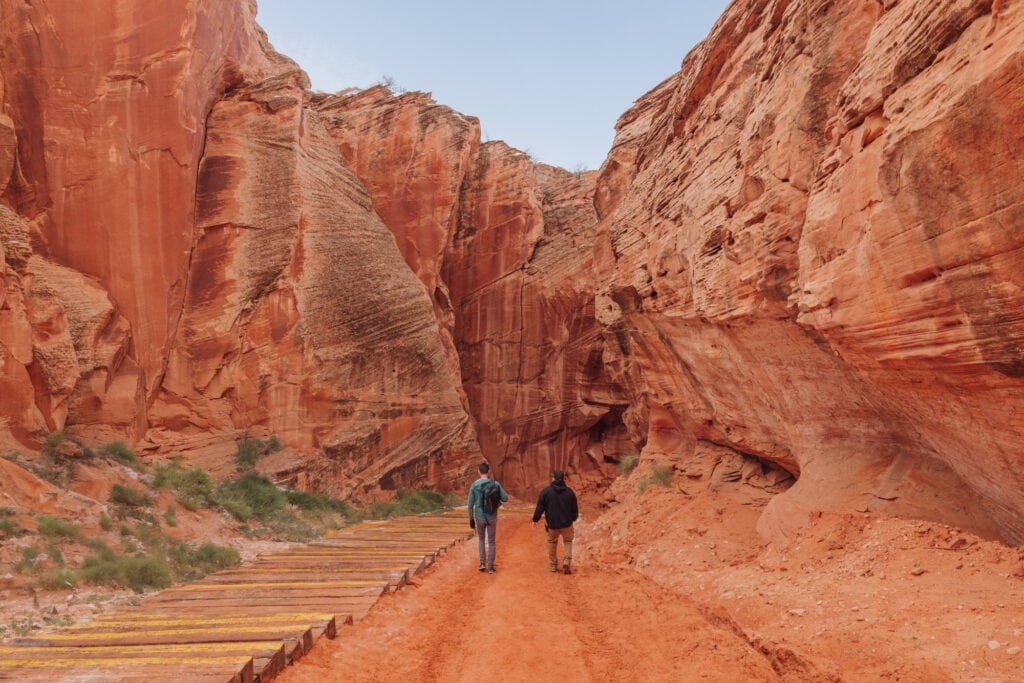
FAQs About a Visit to Cardiac Canyon
Let’s go over a few frequently-asked-questions.
Can you go to Cardiac Canyon on your own?
No. You’ll need to book a tour with Navajo guides to visit Cardiac Canyon, or any other part of Antelope Canyon. The slot canyons run through land privately owned by Navajo families
What’s the least crowded Antelope Canyon tour?
Without a doubt, it’s Cardiac Canyon. Only a handful of visitors are allowed into the canyon each day, compared to more than a thousand at Upper and Lower Antelope Canyon.
Are there photography tours at Antelope Canyon?
Photographers are banned from taking tripods at Upper and Lower Antelope. Antelope Canyon X offers a special tour for photographers, and you can also bring some camera equipment with you on a tour of Cardiac Canyon.
Is the Cardiac Canyon hike hard?
Yes, it’s far more strenuous than some of the other Antelope Canyon options (hence the name: Cardiac). You’ll have to hike down, then up a steep hill in and out of the canyon.
What are you allowed to bring to Cardiac Canyon?
In addition to a camera and tripod, you can bring a book to read, some food, and basic necessities for the 6-hour visit.
Their list of suggestions includes:
- Water
- Sunscreen
- Hiking shoes/clothing
- Camera
- Backpack
- Hat
- Extra batteries/SD cards
- Sweater or coat during the winter
What’s the cancellation policy?
Cancel at least 72 hours before your tour for a full refund.
If they cancel due to poor weather or a risk of flash flooding, they’ll notify people with reservations by email and phone. You’ll get a full refund, or the option to reschedule.
How do you get to Page, AZ?
You can drive to the area, which is 275 north of Phoenix, and 275 miles east of Las Vegas. The closest airport to Cardiac Canyon is right in Page, AZ. Another option is to fly to St. George Utah, which is a beautiful 2-hour drive away.
I usually suggest visiting Sedona and the Grand Canyon if you’re making the trip to Page.
Why is it called Antelope Canyon?
Until recent history, the desert was full of herds of antelopes, grazing on the land above the slot canyon now known as Antelope Canyon.
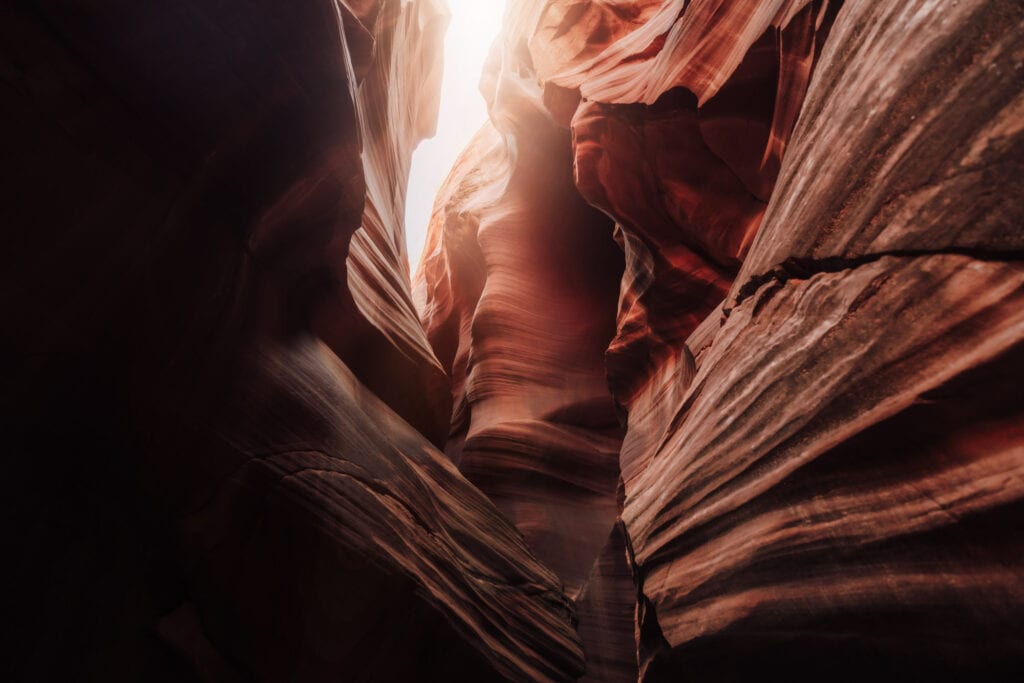
Wrap: Is Cardiac Canyon Worth It?
Cardiac Canyon is the tour to book if you fit one of these categories:
- You’re looking for a more personalized experience at Antelope Canyon, and to learn more about the land, culture, and people who’ve lived here for centuries.
- You’re a photographer, looking to escape the crowds and have the time you need to capture images of the waves in the sandstone walls, as the light changes through the day.
It’s truly a special place, and the family operating tours here created a unique experience for visitors to Cardiac Canyon!
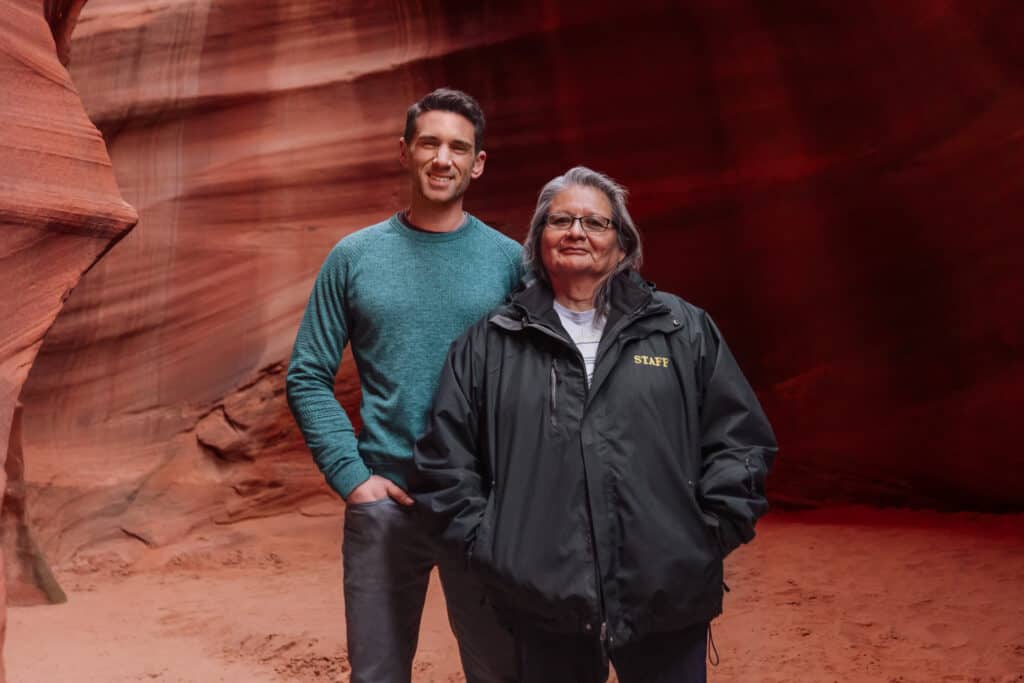
You’ll learn more about the Navajo culture at other sites in the region, like Monument Valley Tribal Park.
Cardiac Canyon Photo Gallery
